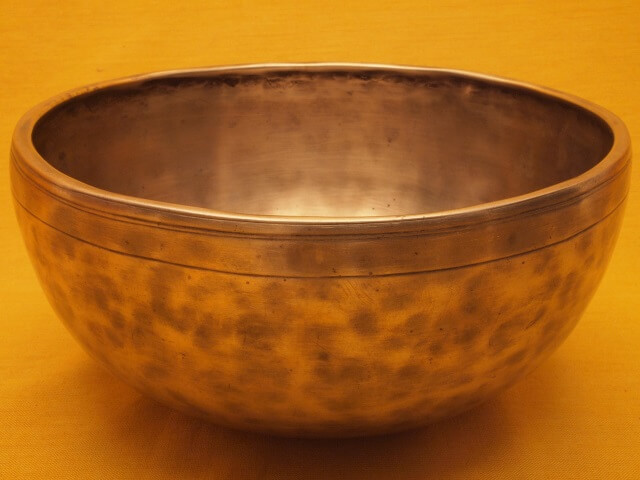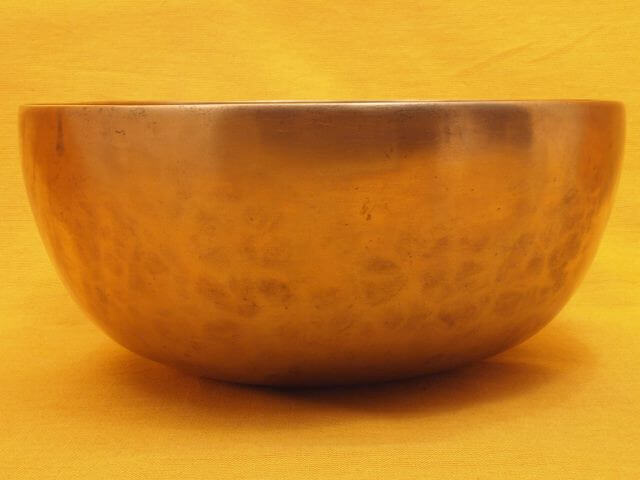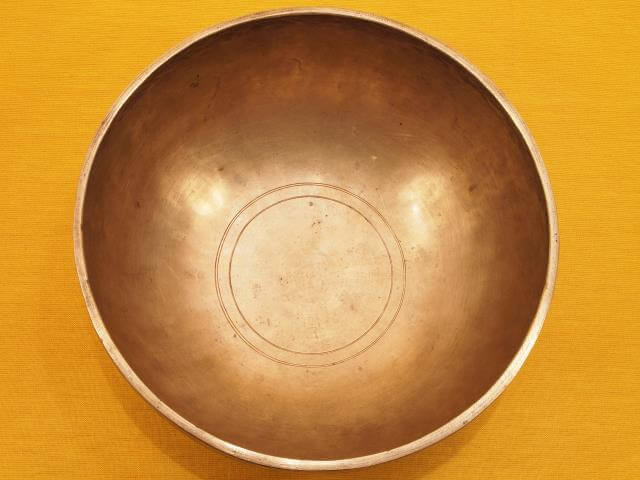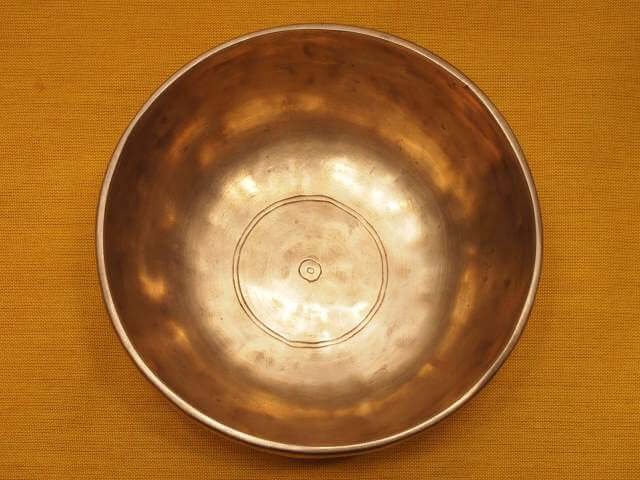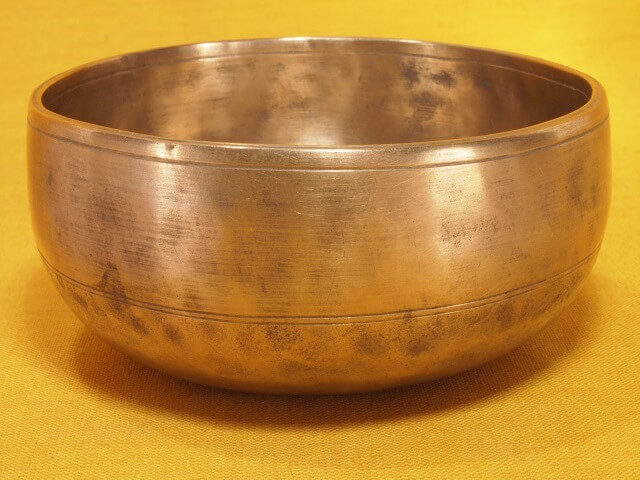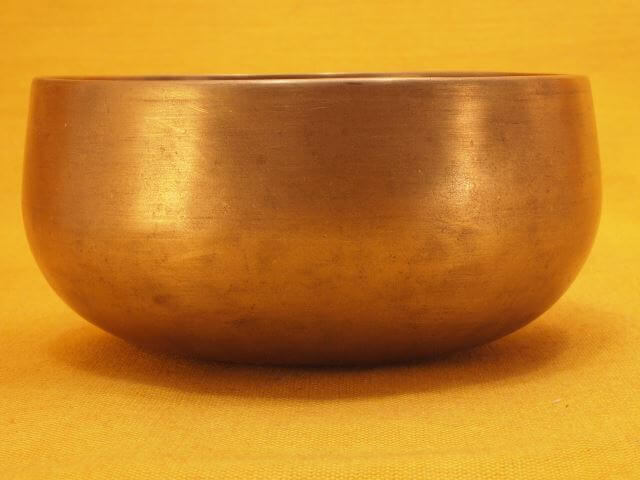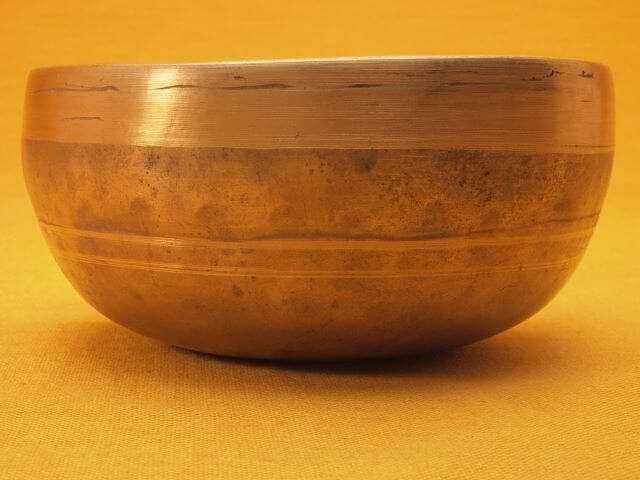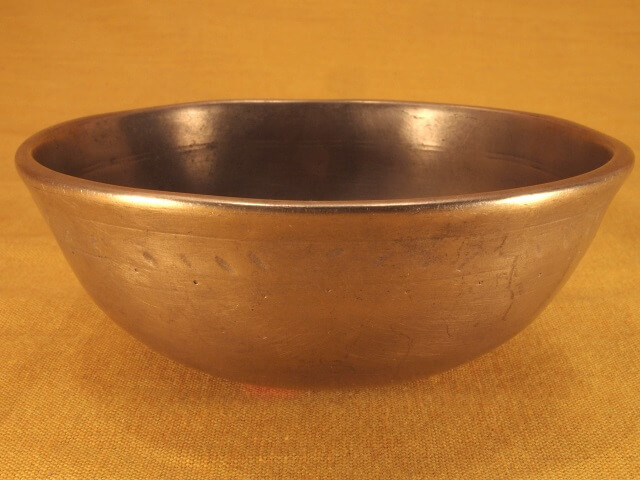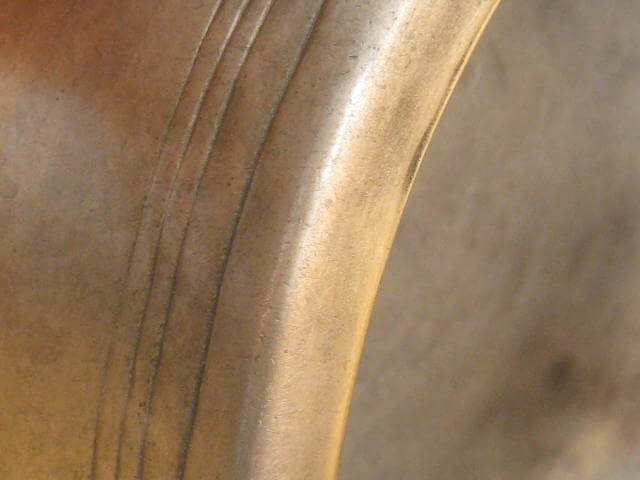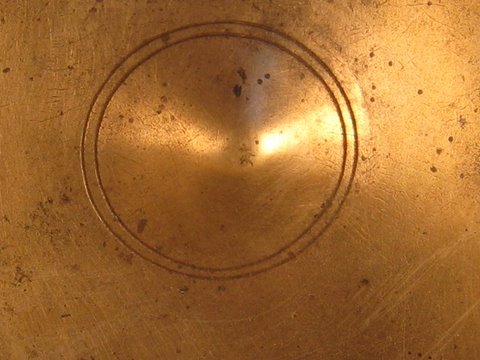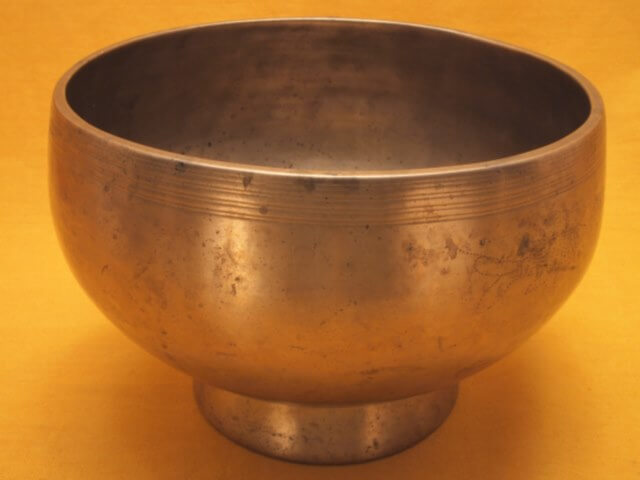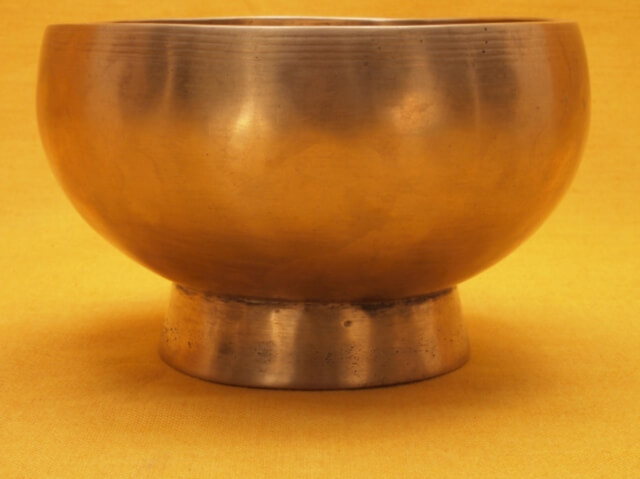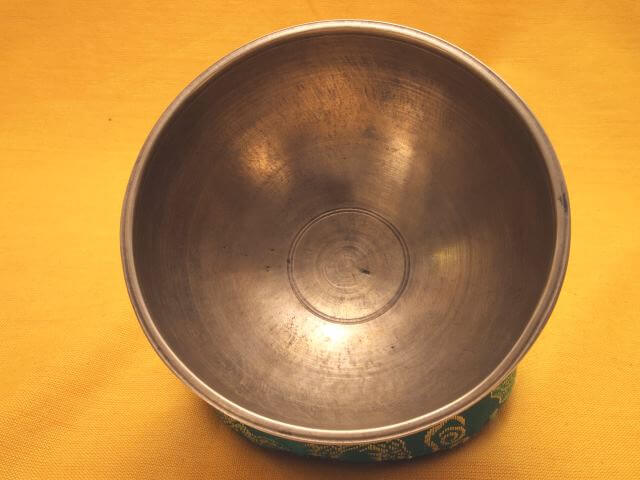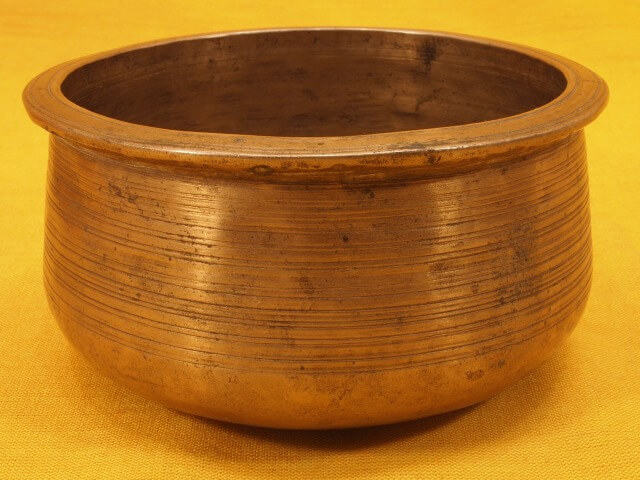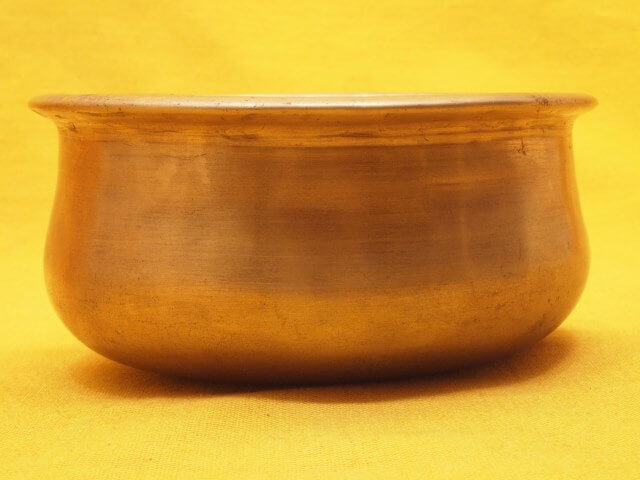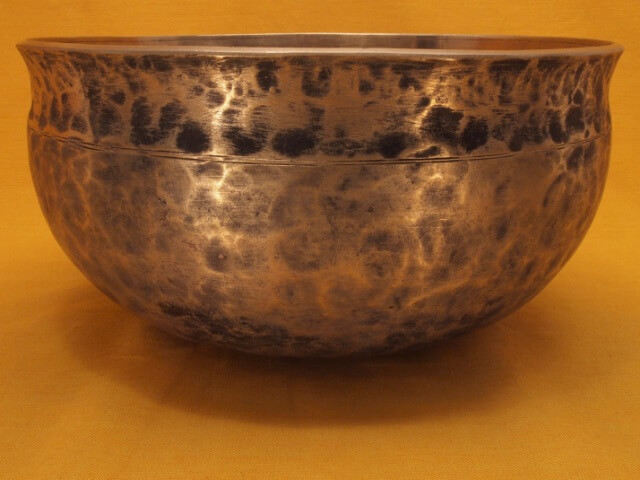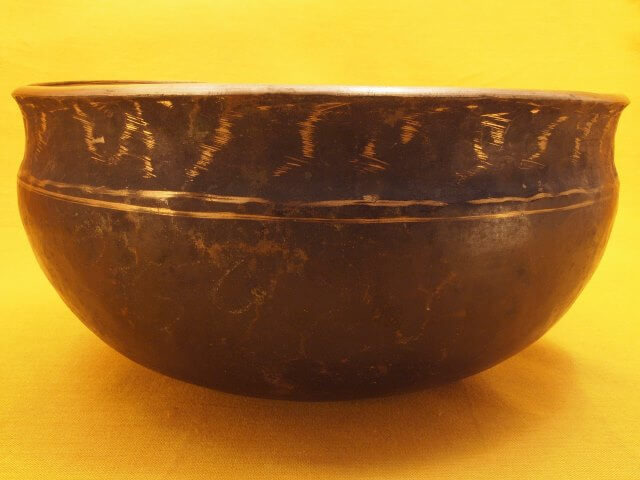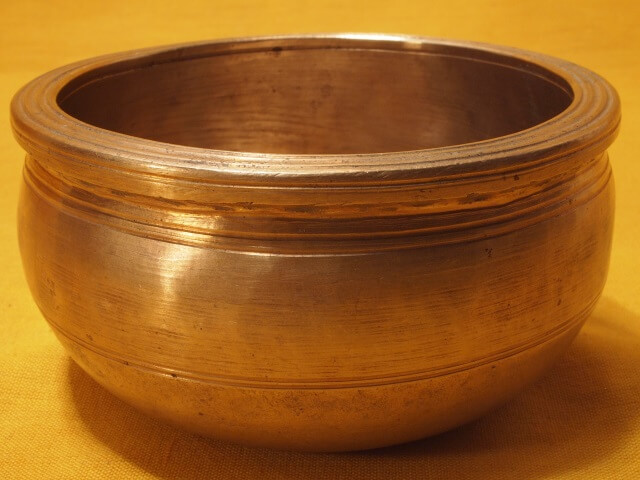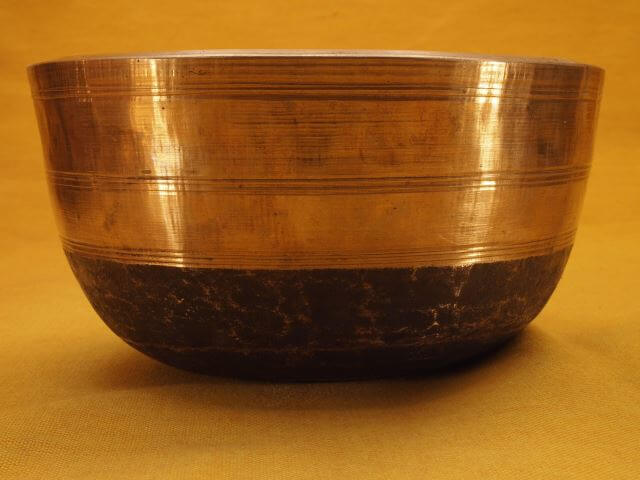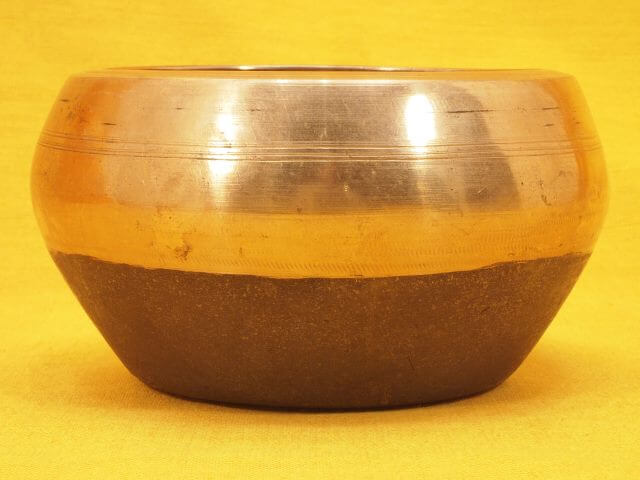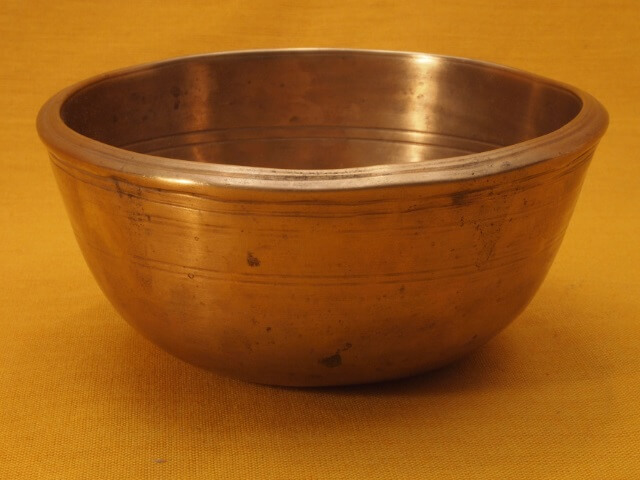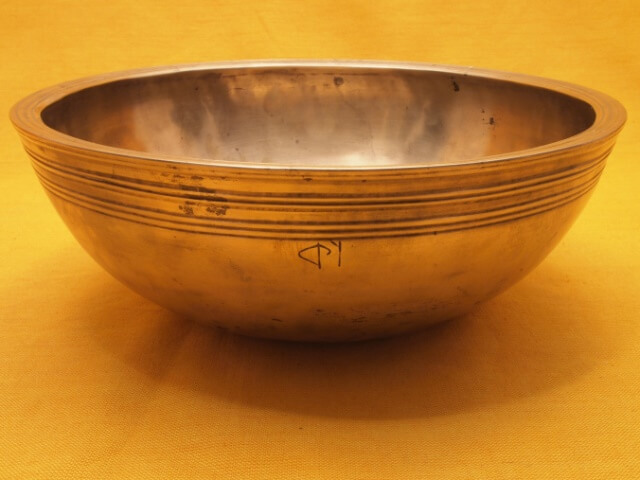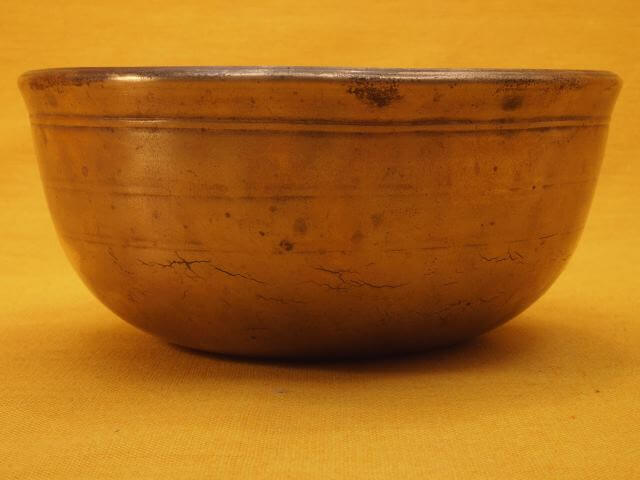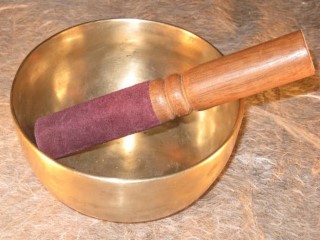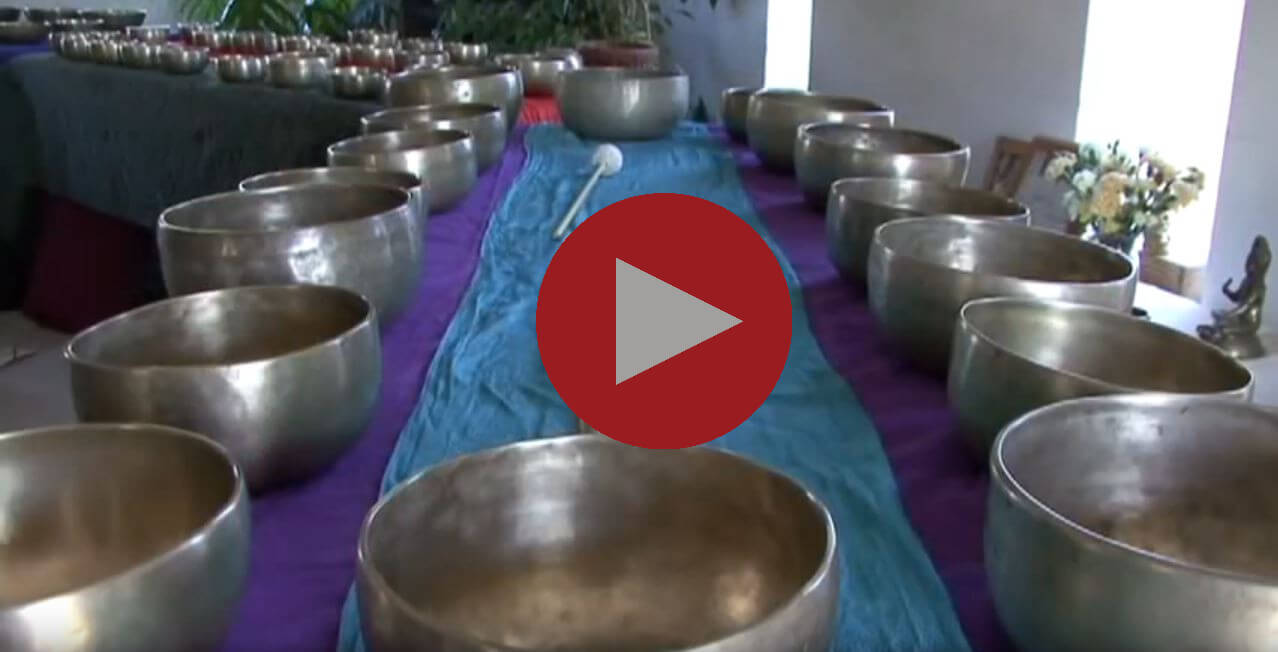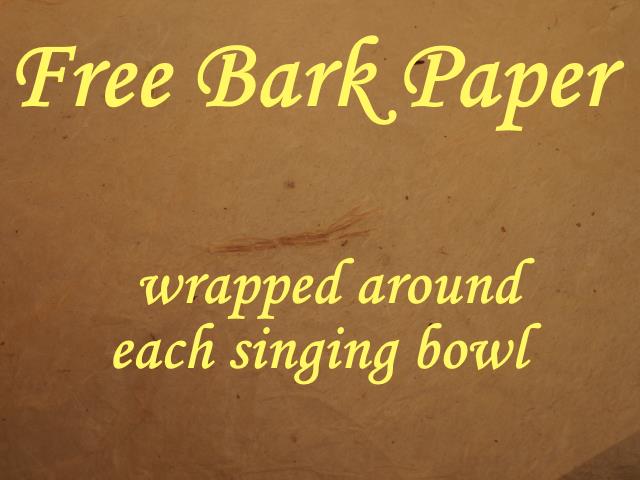Different Types of Singing Bowls
Jambati
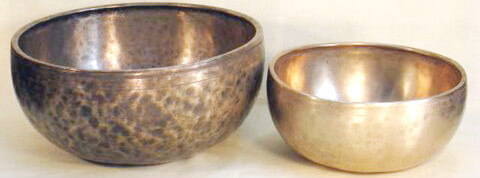
Jambati bowls often have visible hammermarks. There are classical etching lines on Jambati bowls – below the rim on the outside and circular markings inside at the bottom. Some very old Jambati have no lines left, they have been worn off from use. Many older Jambati were made with a flattened rim, very old examples can have a broad flat rim with its own set of etched lines. These have become quite rare in recent years. Jambati bowls were often used for relatively clean purposes such as grain storage so bowls hundreds of years old can have a high level of preservation. The Jambati singing bowl type, especially darker ones possibly indicating the presence of thunderbolt metal (iron), was preferred by Tibetans.
The vast majority of Jambati are in the 2nd and 3rd octave with an occasional small extra thick bowl ringing at the very low end of the middle octave.
Thadobati
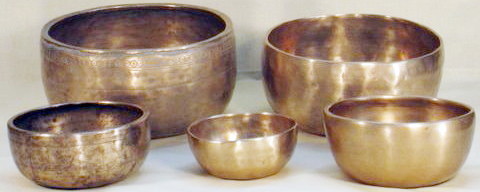
Thado means straight. Thadobati singing bowl types are defined by relatively vertical sides and flat bottoms. Some Thadobati singing bowls are rounder then others however the most common ones have a bottom diameter only slightly smaller than the diameter of the opening. Thadobati singing bowls are relatively deep, up to 5″, while a 9″ diameter is about the largest size you will see in this style.
Thadobati style may be the most ancient common singing bowl, with simple thick examples dating back well over 500 years. These thick old singing bowls will weigh more than a similar diameter Jambati singing bowl. The Thadobati style, especially those with a high copper content and a golden color were preferred by Nepalese.
Thadobati singing bowls usually have no discernible lip overhang and be quite thin from extensive abrasive cleaning over the centuries. Some Thadobati come with interesting punched and etched decorative markings. You could say there are different sub-styles of Thadobati bowls based on recurrent marking patterns but there is no commonly accepted nomenclature to describe these styles. You can see some fanciful names for these styles but this is modern marketing, not tradition.
Singing bowls in the Thadobati style range in tone over four octaves, the widest range of any style. It would be possible to put together a hundred bowl set, all with discernably different strike tones. Thick small Thadobati bowls can be very high well up into the 6th octave while thinner large bowls go down to the bottom of the 3rd. A few rare examples can ring in the upper ranges of the very low 2nd octave.
Remuna
Another type of Tibetan singing bowl is Remuna. Remuna singing bowls are similar to Thadobati in shape and timbre. Since they have a similar soundscape they mix seamlessly with Thadobati in sets. The difference between a Remuna and a Thadobati is the Remuna have inward sloping walls to go with their flat bottom. Remuna bowls are very strong on artwork.
Remuna bowls tend to sport complex artwork. They often have deep etching with circles inside and out, even occasionally on the bottom of the bowl. It is not uncommon for Remuna bowls to have two textures outside, with a darker and rougher bottom half of the bowl. Inscriptions are more common on Remunas than any other type bowl. As with all antique singing bowls artwork may be worn away through long years of use.
Remunas tend to be thinner than Thadobati and you never see an extra thick one. The origin of the name Remuna is not clear, however there is a Remuna town and district on the northwest side of the bay of Bengal, south of Bhutan.
Manipuri

Manipuri are the original singing bowls. When singing bowls first were introduced Western travelers in the 1970s this was by far the most common type. At the time most singing bowls were coming from Tibet on the back of refugees. Due to their metallic content they were easily sold to buyers in India and Nepal. The name Manipuri, however, comes from a state in Northeastern India. This is possibly due to that state being a center of production for brass objects.
There are many sub-styles of Manipuri bowls. No doubt over the last ten centuries millions of these were made and it is easy to imagine different makers using slightly different techniques. Manipuri bowls can be quite old and worn. They were used so extensively that thick elaborately etched bowls eventually became thin smooth bowls with no markings. it is not unusual to see a worn bowl with less than half the thickness of a well preserved version of the same sub-style. Much more so than Thadobati bowls, Manipuri were made with many hammermarks and fine craftsmanship so that they were quite smooth and even when brand new. This is not always true but a roughly made Manipuri is unusual.
Manipuri singing bowls were made in quite a range of sizes from tiny 3 inch bowls to ones a foot across. Due to their range of sizes, and also thickness, Manipuri have a very wide range of primary tones, from the lower second octave to the top of the 5th. The very worn Manipuri bowls can have exquisite sound. The shape of Manipuri bowls gives them a timbre that blends well with Jambati.
Mani
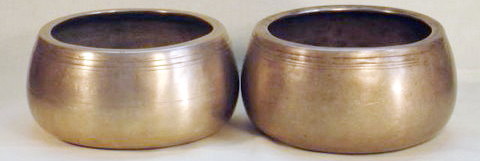
Sometimes also known as Mudra, these rare singing bowl types have thick walls, flat bottoms, and are wider in the middle than at the bottom or lip. Their inward slope is that of the classic begging bowl though they are much larger. Decorative markings are standard though sometimes faint due to wear. Mani singing bowls generally are dated from the late 16th to the 19th century. These bowls were often given as wedding gifts, their great weight being a storehouse of value.
Despite their size Mani bowls tend to be very high in tone, they run counter to the general rule that larger heavier singing bowls are lower in tone. It is quite rare to find a Mani that is as low as the upper range of the middle octave, which is a pretty high sound. The vast majority ring in the 5th octave with some examples starting in the 6th. Manis tend to have smooth broad rims and are very easy to play with a ringing stick.
Lingam
Lingam or Lingam refers to male principle sometimes embodied as the Hindu god Shiva. A lingam is a protrusion of metal in the center of a singing bowl. Lingam bowls along with medicine bowls are the type of singing bowl most likely made for ritual purposes.
The most common lingam bowls are Manipuri style. Lingams always start out as adorned with extensive etching inside and out. The central lingam itself often has designs. Extra thick very old Thadobati bowls also come with lingams. Rare large ancient lingam bowls can come in a distinct rounded style, reminiscent of a Jambati, or the linham feature can be incorporated into other bowl styles, especially Manipuri and Jambati.
In modern times some Manipuri lingam bowls have fallen from ceremonial to household use. I’ve seen small very worn Manipur lingams referred to as “licker” bowls.
Due to the fact that they are so rare and expensive there has been a recent plague of fake Thadobati and special lingam bowls on the market. Fake lingams are often new bowls dressed up as old and sometimes old bowls with the lingam added later. A genuine old lingam will have consistent metal at the bottom of the bowl because the makers made sure there was extra material there with which to build a strong lingam. A modern bowl and especially a reworked old bowl will have thinner metal and often discoloration. Some reworked old lingam bowls have a dollop of metal added before hammering. Unfortunately I see fake lingams sold on the web, even by vendors who should know better.
I would estimate there are less than a dozen good sounding genuine Thadobati and special lingam singing bowls coming out of Asia in a given year.
Pedestal
Pedestal or “stand” bowls are sometimes known by the more prosaic name “Naga”. These bowls have a rounded bottom and an attached base so the bowl can be placed on a flat surface. Inscriptions are common on pedestal bowls, some of which indicate ceremonial use, others identify the bowls as gifts.
Pedestal bowls are generally on the thinner side though some older ones can be quite thick. Sizes range from 4 to 10 inches. Correspondingly, the range of notes is large, third to sixth octave.
Sound quality can be a problem for pedestal bowls, and I pass on many attractive looking bowls due to inferior sound. In Pedestal bowls the base can be loose and cause distortion while the round shape and thin walls are often not conducive with sonic depth.
Trapezoid
Every once in a while a “new” antique singing bowl type emerges. In the past an occasional Trapezoid shape would pop up here and there, then in 2013 the quantities suddenly jumped. In the past the Trapezoid bowls that would surface were large, thin and often not very sonic. What’s come to the market recently are smaller thicker bowls some of which sound incredibly sweet. My theory is that some village in some Himalayan regional backwater was “found” by the antique bowl collectors. In this village there was a tradition, maybe maintained by a single family, of making this style. A little time capsule treasure trove was waiting for just the right moment.
These bowls have straight, symmetrically sloped in sides and a flat bottom and straight top, viewed from the side a perfect Trapezoid. They all seem to have been made with similar markings, many parallel exterior lines and groups of inner circles. The rims are broad and outward facing with etching lines. Some of the very oldest examples have broad rims worn down to nubs. Who knows how many years of use that took.
Trapezoid bowls come in two distinct groups of sizes, small ones are around 5 inches, large ones 7-8 inches. The small ones tend to be high, 4th and 5th octave while the larger ones, very difficult to find with good sound, are lower than you would expect for being only 2 inches larger.
Ultabati
Ultabati singing bowls similar to Jambati style and come in similarly large sizes over 7″. Their distinguishing feature is that the side of the bowl is curved in under the rim. These bowls are not very common which makes them difficult to find with better sound quality. Ultabati bowls often have prominent hammermarks. They can come darkened, even black, on the outside and bright in the interior. Etching lines are similar to Jambati bowls but much less commons.
While Jambati bowls were a favorite in Tibet Ultabati seem to be more of a Northern Indian bowl. Ultabati bowls have the same low tones of Jambati. Indeed some of the deepest tones I have come across are thinner large Ultabati, starting at the bottom end of the 2nd octave.
Unique Singing Bowls
Occasionally you will come across bowls that simply don’t fit into any category or style. These different types of singing bowls seem to have the same cultural context, and similar metal, markings, and sizes. If they sound good, if they sing, regardless of what they were made for then they’ll find their way into the singing bowl market. Some are very much one of a kind, others are rare but some examples come in every year.












